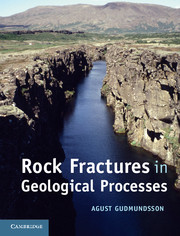Book contents
- Frontmatter
- Contents
- Preface
- Acknowledgements
- 1 Introduction
- 2 Stress
- 3 Displacement and strain
- 4 Relation between stress and strain
- 5 Loading of brittle rocks to failure
- 6 Stress concentration
- 7 Theories of brittle failure of rocks
- 8 Extension fractures and shear fractures
- 9 Displacements and driving stresses of fractures
- 10 Toughness and fracture mechanics
- 11 Field analysis of extension fractures
- 12 Field analysis of faults
- 13 Evolution of extension fractures
- 14 Evolution of faults
- 15 Fluid transport in rocks – the basics
- 16 Fluid transport in faults
- 17 Fluid transport in hydrofractures
- Appendix A Units, dimensions, and prefixes
- Appendix B The Greek alphabet
- Appendix C Some mathematical and physical constants
- Appendix D Elastic constants
- Appendix E Properties of some crustal materials
- Index
- References
10 - Toughness and fracture mechanics
Published online by Cambridge University Press: 05 June 2012
- Frontmatter
- Contents
- Preface
- Acknowledgements
- 1 Introduction
- 2 Stress
- 3 Displacement and strain
- 4 Relation between stress and strain
- 5 Loading of brittle rocks to failure
- 6 Stress concentration
- 7 Theories of brittle failure of rocks
- 8 Extension fractures and shear fractures
- 9 Displacements and driving stresses of fractures
- 10 Toughness and fracture mechanics
- 11 Field analysis of extension fractures
- 12 Field analysis of faults
- 13 Evolution of extension fractures
- 14 Evolution of faults
- 15 Fluid transport in rocks – the basics
- 16 Fluid transport in faults
- 17 Fluid transport in hydrofractures
- Appendix A Units, dimensions, and prefixes
- Appendix B The Greek alphabet
- Appendix C Some mathematical and physical constants
- Appendix D Elastic constants
- Appendix E Properties of some crustal materials
- Index
- References
Summary
Aims
Rock strengths, such as tensile and shear strength, are one measure of its resistance to brittle failure. Another measure of rock resistance to brittle failure is the energy absorbed by the rock during fracture propagation. The critical energy absorbed is referred to as material toughness. A third measure of resistance to fracture is the stress intensity at the fracture tip that must be reached if the fracture is to propagate. The critical stress intensity is referred to as fracture toughness. Toughness is a basic concept in fracture mechanics that provides a physical framework for understanding many processes associated with rock fractures. The main aims of this chapter are to:
Explain the concept of material toughness.
Explain the concept of fracture toughness.
Show how material and fracture toughness are related.
Relate the concept of toughness to the initiation of a fracture.
Introduce the concepts of process zone, fault core, and damage zone.
Show how to calculate the toughness associated with extension fractures.
Show how to calculate the toughness associated with faults.
Toughness
The toughness of a rock is a measure of its resistance to fracture. In other words, for a tough rock, large amounts of energy are needed to cause failure; much energy is absorbed by a tough rock as it fractures. This concept and the related concept of fracture toughness derive from materials science (Hull and Clyne, 1996; Chawla, 1998; Kobayashi, 2004) and fracture mechanics (Atkins and Mai, 1985; Broberg, 1999; Anderson, 2005).
- Type
- Chapter
- Information
- Rock Fractures in Geological Processes , pp. 288 - 318Publisher: Cambridge University PressPrint publication year: 2011

